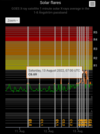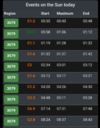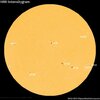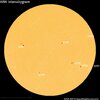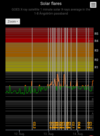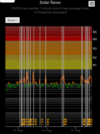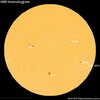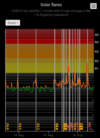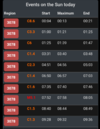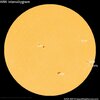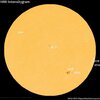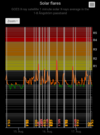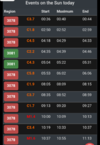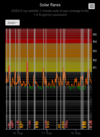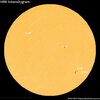SOLAR CYCLE 25 ACTIVITY REPORT AUG 13
Sun activity may be picking up. There were seven minor C class flares in the past day. Plus we saw filaments and prominences dancing all around the solar disk. The largest solar event of the period was a long duration C6.9 that started at 07:14 UTC and end at 07:48 on August 13, 2022 from AR3079 In fact, all seven solar flares came from the same region.
▪︎Another Sundiving comet
There are currently 8 numbered sunspot regions on the disk: AR3071, AR3074, AR3076, AR3077, AR3078, AR3079, AR3080 and new region AR3081
AR3081 Is a group of nine sunspots located on the northeast (N12E50) with a beta magnetic field and a size of 100MH. This region has the energy to produce class C eruptions with a 50% chance of occurrence.
All of these sunspots have stable magnetic fields, no threat for strong flares M or X. The total number of sunspots has increased to 97
OPINION: 2003 Halloween event as an example (in modern times) that refutes the alleged "worst case scenario" during solar cycle 25 that is promoted by the media
▪︎Auroral Activity
The geomagnetic field has been at quiet levels for the past 24 hours. Solar wind speed reached a peak of 581 km/s at 12/01:59 UTC Geospace is expected to be unsettled during August 13, as high-speed solar wind from a equatorial coronal hole diminishes.
Current Conditions at 13:30 UTC August 13
▪︎Geospace quiet
▪︎Geomagnetic conditions now KP=3
▪︎Solar wind speed record: 516.5 km/sec
▪︎density: 9.61 protons/cm3
▪︎Neutron Counts today: +1.5% Elevated
▪︎Sunspot number: 97 (SN 58 Aug 12)
▪︎Solar wind flowiing from this long equatorial coronal hole should reach Eath on August 18-19.
Sun activity may be picking up. There were seven minor C class flares in the past day. Plus we saw filaments and prominences dancing all around the solar disk. The largest solar event of the period was a long duration C6.9 that started at 07:14 UTC and end at 07:48 on August 13, 2022 from AR3079 In fact, all seven solar flares came from the same region.
▪︎Another Sundiving comet
There are currently 8 numbered sunspot regions on the disk: AR3071, AR3074, AR3076, AR3077, AR3078, AR3079, AR3080 and new region AR3081
AR3081 Is a group of nine sunspots located on the northeast (N12E50) with a beta magnetic field and a size of 100MH. This region has the energy to produce class C eruptions with a 50% chance of occurrence.
All of these sunspots have stable magnetic fields, no threat for strong flares M or X. The total number of sunspots has increased to 97
OPINION: 2003 Halloween event as an example (in modern times) that refutes the alleged "worst case scenario" during solar cycle 25 that is promoted by the media
In June 21 the Ministry of the Interior and Communications (MIC) published the report of the "Study Group on the Advancement of Space Weather Forecasting". This was covered in the media, and "solar flares" seemed to be a trending topic.
More than a month after the release of the MIC report, "solar flares" are still attracting attention in various media. I would like to take this opportunity to explain about extreme solar flares, which are the premise of the "worst-case scenario assumption,"
The worst-case scenario for space weather is based on the assumption of "a series of X10-class or larger flares over a two-week period". This two-week period corresponds to half of the Sun's rotation as seen from the Earth (see below). In other words, a sunspot will emerge from the Sun's eastern rim and produce a series of flares until it dips to the western rim.
The scale of a flare is determined by looking at the peak X-ray values measured by the U.S. GOES meteorological satellite and combining the scale labels A, B, C, M, and X, from smallest to largest, with a number between 1 and 10
X10 is one digit above the normal X class scale range.
Intense activity with multiple X10-class flares while sunspots are visible on the solar surface has occurred in the past, though rarely. The most recent well-known example is the "2003 Halloween Event" which occurred in late October/early November 2003.
During the 2003 Halloween event, X17.2, X10.0, and X28+ flares occurred over an eight-day period from October 28 to November 4. The X28+ flare on November 4 exceeded the upper limit (X17.4) of the GOES satellite's onboard X-ray sensor, so the peak is an estimate and the largest flare measured in X-rays. It is the largest flare ever measured in X-rays.
The 2003 Halloween event was also accompanied by frequent coronal mass ejections (CMEs), in which a portion of the solar corona is ejected into space in a blast-like manner in conjunction with a flare. Some CMEs arrived at Earth and caused severe magnetic storms, resulting in a red low-latitude aurora in Rikubetsu, Hokkaido, Japan.
Large flares occur in large sunspot groups, and the X17.2, X10.0, and X28+ flares of late October and early November 2003 were caused by AR10486, a sunspot group in the southern hemisphere of the Sun with an area as large as Jupiter's diameter. Sunspot groups of this size can be seen with the naked eye using eclipse glasses even without a telescope.
The current peak of the 25th solar activity cycle is expected to occur around 2025. Focusing on the number of solar flares, both C-class and above flares and X-class ones increase with the number of sunspots (see graph). However, based on this, we cannot say with certainty that extreme solar flares of X10 or higher will occur in 2025.
▪︎Auroral Activity
The geomagnetic field has been at quiet levels for the past 24 hours. Solar wind speed reached a peak of 581 km/s at 12/01:59 UTC Geospace is expected to be unsettled during August 13, as high-speed solar wind from a equatorial coronal hole diminishes.
Current Conditions at 13:30 UTC August 13
▪︎Geospace quiet
▪︎Geomagnetic conditions now KP=3
▪︎Solar wind speed record: 516.5 km/sec
▪︎density: 9.61 protons/cm3
▪︎Neutron Counts today: +1.5% Elevated
▪︎Sunspot number: 97 (SN 58 Aug 12)
▪︎Solar wind flowiing from this long equatorial coronal hole should reach Eath on August 18-19.

